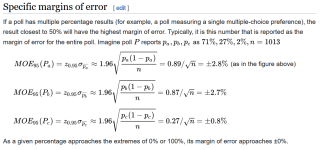Jayjay
Contributor
- Joined
- Apr 7, 2002
- Messages
- 7,173
- Location
- Finland
- Basic Beliefs
- An accurate worldview or philosophy
So I was reading wikipedia, and stumbled upon this:
https://en.wikipedia.org/wiki/Margin_of_error#Specific_margins_of_error

(Sorry, easier to screen capture than convert the equation symbols.)
I don't get the last sentence and the formula. If the reported probability with some N is 0% or 100%, to me it seems that it is still possible that there is an error and the probability of answers is just small compared to N. Let's say a probability of an event is one out of a million. If I take hundred samples, the probability that none of them match is still about 1 out of 10,000. So the result for the poll would likely be 0% for that event. Shouldn't the margin of error reflect that somehow?
In an extreme case, I take one sample. Margin of error is always zero?
I'm trying to think of this in terms of margins of errors that are reported in opinion polls. Obviously, there are many other factors that impact the accuracy of polls, but here I'm just focusing on the statistical error. So assuming that the sampling is perfectly random, the population size is infinite, and the polling company logo is a perfect circle.
https://en.wikipedia.org/wiki/Margin_of_error#Specific_margins_of_error

(Sorry, easier to screen capture than convert the equation symbols.)
I don't get the last sentence and the formula. If the reported probability with some N is 0% or 100%, to me it seems that it is still possible that there is an error and the probability of answers is just small compared to N. Let's say a probability of an event is one out of a million. If I take hundred samples, the probability that none of them match is still about 1 out of 10,000. So the result for the poll would likely be 0% for that event. Shouldn't the margin of error reflect that somehow?
In an extreme case, I take one sample. Margin of error is always zero?
I'm trying to think of this in terms of margins of errors that are reported in opinion polls. Obviously, there are many other factors that impact the accuracy of polls, but here I'm just focusing on the statistical error. So assuming that the sampling is perfectly random, the population size is infinite, and the polling company logo is a perfect circle.
